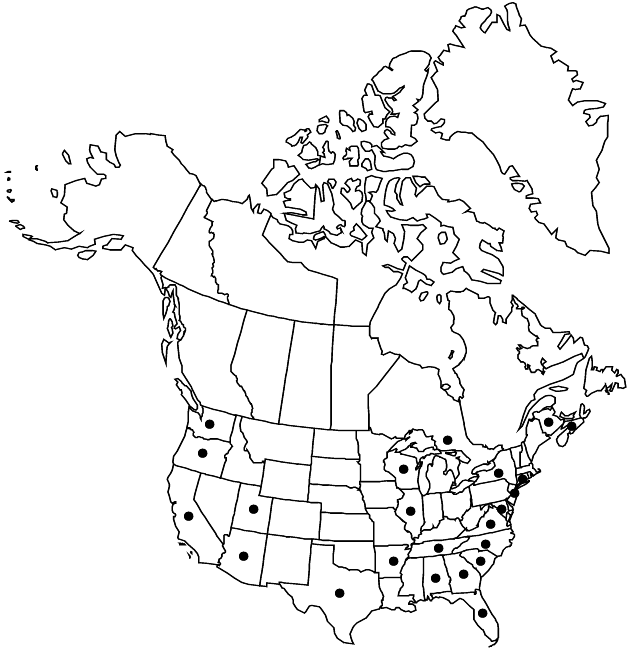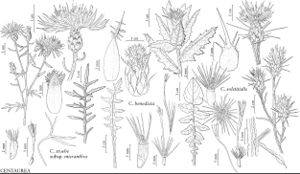Centaurea benedicta
Sp. Pl. ed. 2, 2: 1296. 1763.
Annuals, to 60 cm. Stems often spreading or prostrate, usually branched throughout, usually reddish, ± loosely tomentose. Leaves mostly cauline, sessile and often short-decurrent or proximal tapering to winged petioles, blades lanceolate to oblanceolate, 6–25 cm, margins coarsely dentate or pinnately lobed, lobes and teeth armed with short, weak spines, faces sparsely to densely hairy with jointed multicellular hairs and slender cobwebby hairs, resin-gland-dotted. Heads disciform, borne singly, sessile, each subtended by involucre-like cluster of leaf-like bracts. Involucres ± spheric, 20–40 mm. Phyllaries in several series, tightly overlapping, outer ovate with tightly appressed bases and spreading spine tips, inner lanceolate, tipped by pinnately divided spines more than 5 mm. Florets many; corollas yellow, those of sterile florets linear, 3-lobed, not exceeding disc corollas, very slender, those of disc florets 19–24 mm. Cypselae cylindric, slightly curved, 8–11 mm, with 20 prominent ribs, tipped by a 10-dentate rim, glabrous, attachment scars lateral; pappi of 2 series of awns, outer 9–10 mm, smooth or ± roughened, inner 2–5 mm, roughened with short spreading hairs. 2n = 22.
Phenology: Flowering spring–summer (Apr–Aug).
Habitat: Roadsides, fields, waste places, sometimes cultivated
Elevation: 0–1300 m
Distribution

N.B., N.S., Ont., Ala., Ariz., Ark. Calif., Conn., Fla., Ga., Ill., Md., N.J., N.Y., N.C., Oreg., S.C., Tenn., Tex., Utah, Va., Wash., Wis., Europe, Asia, widely introduced worldwide.
Discussion
Centaurea benedicta is native to the Mediterranean region and Asia Minor. F. K. Kupicha (1975) recognized two varieties of Cnicus benedictus: var. benedictus and var. kotschyi Boissier. A combination apparently has not been made for var. kotschyi in Centaurea. I have not determined whether one or both races are represented in North American plants of Centaurea benedicta.
Blessed thistle is cultivated in many areas of the world as a medicinal herb. The leaves, stems, and flowers are all used in herbal preparations for digestive and liver ailments.
Selected References
None.
